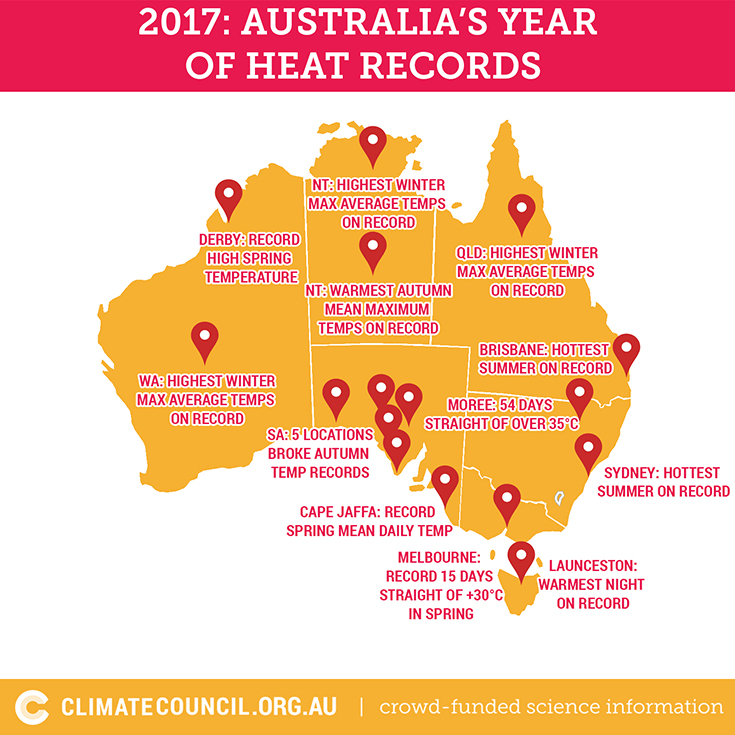Climate change an ‘Existential threat’ as 2017 among three warmest years on record
UN Secretary-General's Special Representative for Disaster Risk Reduction, Robert Glasser, has described the accelerating pace of climate change as: “An existential threat to the planet.”
The Earth’s global surface temperatures in 2017 ranked as the second warmest since 1880, according to an analysis by NASA. In a separate, independent analysis, scientists at the National Oceanic and Atmospheric Administration (NOAA) in the US concluded that 2017 was the third warmest year in its records. The difference in rankings is down to the methods used to analyse global temperatures, although over the long-term, the agencies’ records remain in strong agreement and both analyses show that the five warmest years on record have all occurred since 2010.

Photo by Ezra Jeffrey on Unsplash
Meanwhile, the World Meteorological Organisation (WMO) is combining datasets from NOAA, NASA, GISS and the Met Office Hadley Centre and Climatic Research Unit (UK) for a consolidated temperature ranking for 2017. The WMO says that the 2017 global land and ocean temperature will likely end among the three warmest years on record, and is expected to be the warmest year without a warming El Niño. The results will be announced in March 2018.
“What is more important than the ranking of an individual year is the overall, long-term trend of warming since the late 1970s, and especially this century,” said WMO senior scientist Omar Baddour. “Along with rising temperatures, we are seeing more extreme weather, with huge socio-economic impacts,” he said.
A NOAA-sponsored report shows that the warming trend transforming the Arctic persisted in 2017, resulting in the second warmest air temperatures, above average ocean temperatures, loss of sea ice, and a range of human, ocean and ecosystem effects.
A separate report, published in the Bulletin of the American Meteorological Society (BAMS), said that last year’s record global average temperatures, extreme heat over Asia, and unusually warm waters in the Bering Sea would not have been possible without human-caused climate change.
"This report marks a fundamental change," says Jeff Rosenfeld, editor-in-chief of BAMS. “For years scientists have known humans are changing the risk of some extremes. But finding multiple extreme events that weren’t even possible without human influence makes clear that we're experiencing new weather, because we've made a new climate.”
Robert Glasser said: “Confirmation that we have now had a three-year streak of record hot years, each above one degree Celsius, combined with record-breaking economic losses from disasters in 2017, should tell us all that we are facing an existential threat to the planet which requires a drastic response.
“Now, with improved understanding of the climate science and extreme event attribution, we can no longer hide behind the fallacious argument that no particular extreme weather event can be attributed to climate change, when such events can occur with such violence and frequency as we saw during last year’s Atlantic Hurricane Season, or with slow onset, in the case of the drought conditions which affected 60 million people in 2016,” he added.
Glasser expressed concern that climate change is combining with poverty, the destruction of protective ecosystems, inappropriate land use, and population growth in hazard-exposed areas, to undermine efforts to eradicate poverty and hunger, and to push more people to leave their homes.
Meanwhile, the Climate Council of Australia has released its report: 2017: Record-breaking year for heat and extreme weather report (download the report here) which says that the The global temperature averaged over the last five years (2013, 2014, 2015, 2016, 2017) has been confirmed as the highest ever on record for any five-year period. This record is part of a sharp, long-term upswing in global temperatures, with 17 out of the 18 years hottest years on record all occurring in this century. Among its findings are:
-
The 2013-2017 period has been the hottest five-year period ever recorded.
-
2017 was the third hottest year ever recorded, and the hottest year in which temperatures have not been boosted by an El Niño event.
-
The world’s 10 hottest years on record have all occurred since 1998 and 17 of the 18 hottest years on record have occurred this century.
-
2017 was Australia’s third hottest year on record.
-
Seven of the ten hottest years on record in Australia have happened since 2005. Five of the seven have occurred the past five years.
-
2017 broke records for hot, dry conditions with more than 260 heat and low rainfall recordsbroken throughout winter.
-
The increasing global heat, driven primarily by the burning of fossil fuels, exacerbated extreme weather events around the globe and in Australia in 2017.
